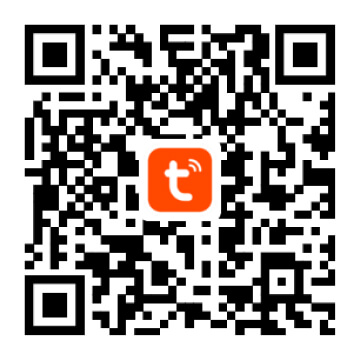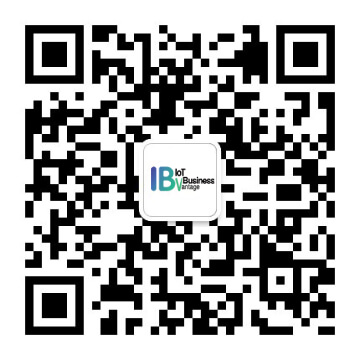WR11-2S 模组规格书
更新时间:2025-07-08 08:27:26下载pdf
WR11-2S 是由杭州涂鸦信息技术有限公司开发的一款低功耗嵌入式 Wi-Fi + 蓝牙双模双频模组。它由一个高集成度的无线射频芯片 RTL8711DAF 和少量外围器件构成,内置了 Wi-Fi 网络协议栈和蓝牙网络协议以及丰富的库函数。
产品概述
WR11-2S 内嵌低功耗的 32 位 MCU、512 KB SRAM、内置 4 MByte 的 FLASH 以及丰富的外设资源。
WR11-2S 是一个 RTOS 平台,集成了所有 Wi-Fi MAC 以及 TCP/IP 协议的函数库。用户可以基于这些开发满足自己需求的嵌入式 Wi-Fi 产品。
特性
- 内置低功耗 32 位 CPU,可以兼作应用处理器
- 主频最高可支持 345MHz
- 工作电压:3.3±0.3V
- 外设:5×PWM、2×UART、1xADC
- Wi-Fi 连通性
- 802.11a/b/g/n 1x1,2.4G&5G
- 通道 1-14@2.4GHz,36-177@5G
- 支持 WEP/WPA/WPA2/WPA2 PSK(AES)WPA3 安全模式
- 802.11b 模式下最大 +18dBm 的输出功率
- 支持 STA/AP/STA + 热点模式 工作模式(除去 UNII-2A/2C 频段)
- 支持 SmartConfig 和 热点模式 两种配网方式(包括 Android 和 iOS 设备)
- 板载 PCB 天线,天线增益 0.95dBi@2.4G,0.7dBi@5G
- 工作温度:-40℃ 到 85℃
- 蓝牙连通性
- 支持蓝牙(Bluetooth 5.0)
- 最高可达到 +9dbm 输出功率
- 板载 PCB 天线,天线增益 0.95dBi@2.4G,和 Wi-Fi 共用天线
- 工作温度:-40℃ 到 85℃
应用领域
- 智能楼宇
- 智慧家居/家电
- 智能插座、智慧灯
- 工业无线控制
- 婴儿监控器
- 网络摄像头
- 智能公交
模组接口
尺寸封装
WR11-2S 尺寸大小:14.99±0.35mm (W) × 17.91±0.35mm (L) × 3.45±0.15mm (H)。WR11-2S 尺寸图如下图所示:
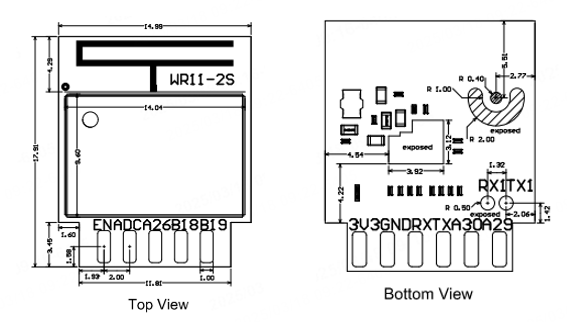
引脚定义
| 引脚 | 符号 | I/O 类型 | 功能 |
|---|---|---|---|
| 1 | 3V3 | P | 电源 3V3 |
| 2 | PB19 | I/O | 支持硬件 PWM,对应 IC 的 Pin 39 |
| 3 | GND | P | 电源地 |
| 4 | PB18 | I/O | 支持硬件 PWM,对应 IC 的 Pin 38 |
| 5 | RX0 | I/O | UART_RX0,用户数据接收口,对应 IC 的 PB21(Pin 41) |
| 6 | PA26 | I/O | 支持硬件 PWM,对应 IC 的 Pin 12 |
| 7 | TX0 | I/O | UART_TX0,用户数据发送口,对应 IC 的 PB20(Pin 40) |
| 8 | PB17 | I/O | ADC 口,对应 IC 的 PB17(Pin 37) |
| 9 | PA30 | I/O | 支持硬件 PWM,对应 IC 的 Pin 16 |
| 10 | CEN | I/O | 复位脚,低电平有效,内部拉高处理,对应 IC 的 Pin 44 |
| 11 | PA29 | I/O | 支持硬件 PWM,对应 IC 的 Pin 15 |
| TP2 | TX1 | I/O | UART_TX1,打印日志口,对应 IC 的 PB5(Pin 35) |
| TP3 | RX1 | I/O | UART_RX1,打印日志口,对应 IC 的 PB4(Pin 34) |
P 表示电源引脚,I/O 表示输入输出引脚。
电气参数
绝对电气参数
| 参数 | 描述 | 最小值 | 最大值 | 单位 |
|---|---|---|---|---|
| Ts | 存储温度 | -40 | 85 | ℃ |
| VBAT | 供电电压 | 3.0 | 3.6 | V |
| 静电释放电压(人体模型) | TAMB-25℃ | - | 2 | KV |
| 静电释放电压(机器模型) | TAMB-25℃ | - | 0.5 | KV |
正常工作条件
| 参数 | 描述 | 最小值 | 典型值 | 最大值 | 单位 |
|---|---|---|---|---|---|
| Ta | 工作温度 | -40 | - | 85 | ℃ |
| VBAT | 供电电压 | 3.0 | 3.3 | 3.6 | V |
| VIL | IO 低电平输入 | - | - | 0.8 | V |
| VIH | IO 高电平输入 | 2.0 | - | - | V |
| VOL | IO 低电平输出 | 0 | - | 0.3 | V |
| VOH | IO 高电平输出 | 2.8 | - | 3.6 | V |
| Imax | IO 驱动电流 | - | - | 12 | mA |
连续发射和接收时功耗
2.4G 发射接收
| 工作状态 | 模式 | 速率 | 发射功率/接收 | 典型值 | 单位 |
|---|---|---|---|---|---|
| 发射 | 11b | 11Mbps | 18 | 322 | mA |
| 发射 | 11g | 54Mbps | 18 | 324 | mA |
| 发射 | 11n-HT20 | MCS7 | 17 | 312 | mA |
| 发射 | 11n-HT40 | MCS7 | 17 | 308 | mA |
| 接收 | 11b | 11Mbps | 连续接收 | 64 | mA |
| 接收 | 11g | 54Mbps | 连续接收 | 64 | mA |
| 接收 | 11n-HT20 | MCS7 | 连续接收 | 64 | mA |
| 接收 | 11n-HT40 | MCS7 | 连续接收 | 64 | mA |
5G 发射接收
| 工作状态 | 模式 | 速率 | 发射功率/接收 | 典型值 | 单位 |
|---|---|---|---|---|---|
| 发射 | 11a | 54Mbps | 17 | 372 | mA |
| 发射 | 11n-HT20 | MCS7 | 16 | 368 | mA |
| 发射 | 11n-HT40 | MCS7 | 16 | 356 | mA |
| 接收 | 11a | 54Mbps | 连续接收 | 64 | mA |
| 接收 | 11n-HT20 | MCS7 | 连续接收 | 64 | mA |
| 接收 | 11n-HT40 | MCS7 | 连续接收 | 64 | mA |
工作电流
| 工作模式 | 工作状态,Ta=25℃ | 平均值 | 最大值(典型值) | 单位 |
|---|---|---|---|---|
| 快连配网状态 | 模组处于快连配网状态,Wi-Fi 指示灯快闪 | 58 | 277 | mA |
| 热点配网状态 | 模组处在热点配网状态,Wi-Fi 指示灯慢闪 | 62 | 288 | mA |
| 网络连接状态 | 模组处于联网工作状态,Wi-Fi 指示灯常亮 | 40 | 414 | mA |
| 断网状态 | 模组处于断网工作状态, Wi-Fi 指示灯常灭 | 40 | 422 | mA |
射频参数
基本射频特性
| 参数项 | 详细说明 |
|---|---|
| 工作频率 | 2.412 GHz to 2.484 GHz(Ch1-11 for US/CA, Ch1-13 for EU/CN),5.180-5.825GHz |
| Wi-Fi 标准 | IEEE 802.11a/b/g/n(Ch1-11 for US/CA, Ch1-13 for EU/CN,通道 36-165) |
| 数据传输速率 |
|
| 天线类型 | PCB 天线,天线增益 0.95dBi@2.4G,0.7dBi@5G |
发射性能
2.4G-TX 连续发送性能
| 参数项 | 最小值 | 典型值 | 最大值 | 单位 |
|---|---|---|---|---|
| RF 平均输出功率,802.11b CCK Mode 11M | - | 18 | - | dBm |
| RF 平均输出功率,802.11g OFDM Mode 54M | - | 18 | - | dBm |
| RF 平均输出功率,802.11n HT20 Mode MCS7 | - | 17 | - | dBm |
| RF 平均输出功率,802.11n HT40 Mode MCS7 | - | 17 | - | dBm |
| 频率误差 | -10 | - | 10 | ppm |
5G-TX 连续发送性能
| 参数项 | 最小值 | 典型值 | 最大值 | 单位 |
|---|---|---|---|---|
| RF 平均输出功率,802.11aOFDM Mode 54M | - | 17 | - | dBm |
| RF 平均输出功率,802.11n HT20 Mode MCS7 | - | 16 | - | dBm |
| RF 平均输出功率,802.11n HT40 Mode MCS7 | - | 16 | - | dBm |
| 频率误差 | -10 | - | 10 | ppm |
接收性能
RX 灵敏度
| 参数项 | 最小值 | 典型值 | 最大值 | 单位 |
|---|---|---|---|---|
| PER<8%,RX 灵敏度,802.11b DSSS Mode 11M | - | -89 | - | dBm |
| PER<10%,RX 灵敏度,802.11a/g OFDM Mode 54 M | - | -77 | - | dBm |
| PER<10%,RX 灵敏度,802.11n OFDM Mode HT20-MCS7 | - | -74 | - | dBm |
| PER<30.8%,RX 灵敏度,蓝牙 5.0 2M | - | -97 | - | dBm |
天线信息
天线类型
只有 PCB 板载天线接入方式。
降低天线干扰
在 Wi-Fi 模组上使用 PCB 板载天线时,为确保 Wi-Fi 性能的最优化,建议模组天线部分和其他金属件距离至少在 15mm 以上。
用户 PCB 板在天线区域勿走线甚至覆铜,以免影响天线性能。
布局要点是:确保印制天线正下方或者正上方没有基板介质,确保印制天线的周围远离金属铜皮,这样可以最大程度上保证天线的辐射效果。
封装信息及生产指导
机械尺寸
WR11-2S 的 PCB 机械尺寸大小:14.99±0.35mm (W) × 17.91±0.35mm (L) × 3.45±0.15mm (H)。WR11-2S 的机械尺寸如下图所示。
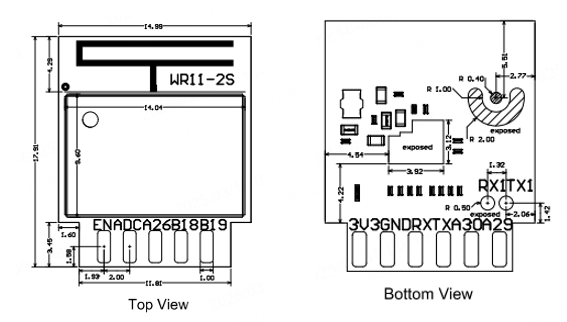
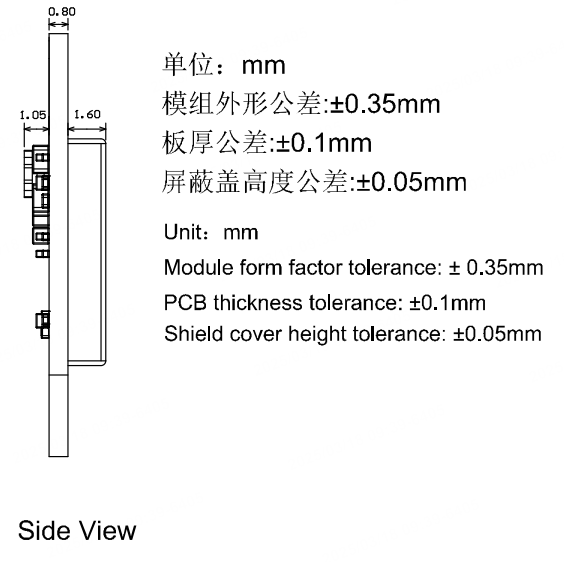
PCB 推荐封装
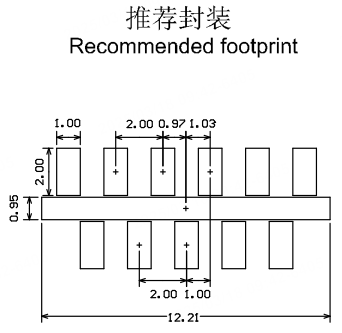
生产指南
-
涂鸦出厂的可贴可插封装模组根据客户底板设计方案选择组装方式,底板设计为贴片封装时使用 SMT 贴片制程进行生产,如果底板设计为插件封装时使用波峰焊制程进行生产。模组产品拆开包装后建议在 24 小时内完成焊接,否则需放置在湿度不超过 10%RH 的干燥柜内,或重新进行真空包装并记录暴露时间,总暴露时间不超过 168 小时。
- (SMT 制程)SMT 贴片所需仪器或设备:
- 贴片机
- SPI
- 回流焊
- 炉温测试仪
- AOI
- (波峰焊制程)波峰焊所需的仪器或设备:
- 波峰焊设备
- 波峰焊接治具
- 恒温烙铁
- 锡条、锡丝、助焊剂
- 炉温测试仪
- 烘烤所需仪器或设备:
- 柜式烘烤箱
- 防静电耐高温托盘
- 防静电耐高温手套
- (SMT 制程)SMT 贴片所需仪器或设备:
-
涂鸦出厂的模组存储条件如下:
-
防潮袋必须储存在温度 <40℃、湿度 <90%RH 的环境中。
-
干燥包装的产品,保质期为从包装密封之日起 12 个月的时间。
-
密封包装内装有湿度指示卡:
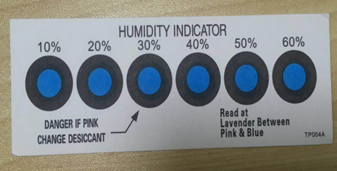
-
-
涂鸦出厂的模组当出现可能受潮的情况下需要进行烘烤:
- 拆封前发现真空包装袋破损。
- 拆封后发现包装袋内没有湿度指示卡。
- 拆封后如果湿度指示卡读取到 10% 及以上色环变为粉色。
- 拆封后总暴露时间超过 168 小时。
- 从首次密封包装之日起超过 12 个月。
-
烘烤参数如下:
- 烘烤温度:卷盘包装 40℃,小于等于 5%RH。托盘包装 125℃,小于等于 5%RH(耐高温托盘非吸塑盒拖盘)。
- 烘烤时间:卷盘包装 168 小时,托盘包装 12 小时。
- 报警温度设定:卷盘包装 50℃,托盘包装 135℃。
- 自然条件下冷却到 36℃ 以下后,即可进行生产。
- 若烘烤后暴露时间大于 168 小时没有使用完,请再次进行烘烤。
- 如果暴露时间超过 168 小时未经过烘烤,不建议使用波峰焊接工艺焊接此批次模组,因模组为 3 级湿敏器件超过允许的暴露时间很可能受潮,进行高温焊接时可能导致器件失效或焊接不良。
-
在整个生产过程中请对模组进行静电放电(ESD)保护。
-
为了确保产品合格率,建议使用 SPI 和 AOI 测试设备来监控锡膏印刷和贴装品质。
推荐炉温曲线
请根据制程选择相应的焊接方式,SMT 参考回流焊接炉温曲线推荐,波峰焊制程参考波峰焊接炉温曲线推荐。设定炉温与实测炉温有一定差距,本文所示温度均为实测温度。
方式一:SMT 制程(SMT 回流焊接推荐炉温曲线)
请参考回流焊炉温曲线要求进行炉温设定,回流焊温度曲线如下图所示:
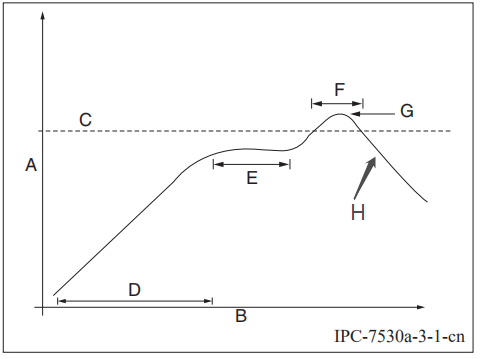
- A:温度轴
- B:时间轴
- C:合金液相线温度区间为 217-220℃
- D:升温斜率为 1-3℃/S
- E:恒温时间为 60-120S,恒温温度区间为 150-200℃
- F:液相线以上时间为 50-70S
- G:峰值温度为 235-245℃
- H:降温斜率为 1-4℃/S
以上推荐曲线以 SAC305 合金焊膏为例。其他合金焊膏请按焊膏规格书推荐炉温曲线设置。
方式二:波峰焊制程(波峰焊接炉温曲线)
请参考波峰焊接炉温建议进行炉温设定,峰值温度 260℃±5℃,波峰焊接温度曲线如下图所示:
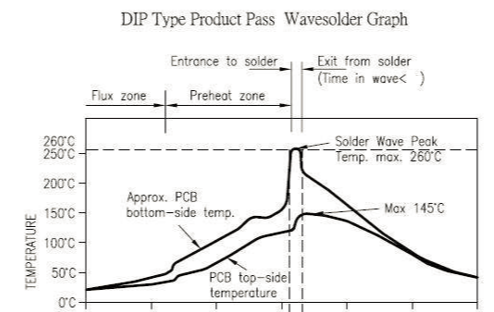
| 波峰焊接炉温曲线建议 | 手工补焊温度建议 | ||
|---|---|---|---|
| 预热温度 | 80-130℃ | 焊接温度 | 360℃±20℃ |
| 预热时间 | 75-100S | 焊接时间 | 小于 3S/点 |
| 波峰接触时间 | 3-5S | NA | NA |
| 锡缸温度 | 260±5℃ | NA | NA |
| 升温斜率 | ≤2℃/S | NA | NA |
| 降温斜率 | ≤6℃/S | NA | NA |
储存条件
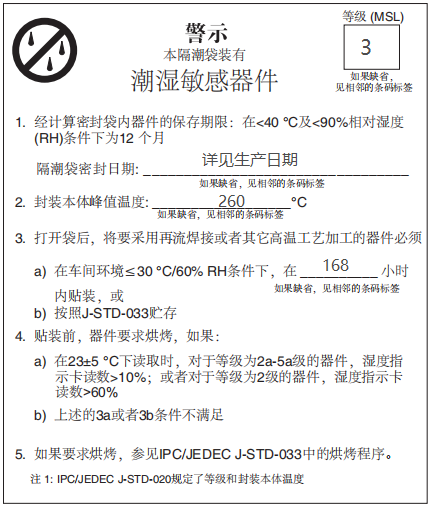
模组 MOQ 与包装信息
| 产品型号 | MOQ(pcs) | 出货包装方式 | 每个卷盘存放模组数 | 每箱包装卷盘数 |
|---|---|---|---|---|
| WR11-2S | 4400 | 载带卷盘 | 1100 | 4 |
附录:声明
Important Notice to OEM integrators
-
This module is limited to OEM installation ONLY.
-
This module is limited to installation in mobile or fixed applications, according to Part 2.1091(b).
-
The separate approval is required for all other operating configurations, including portable configurations with respect to Part 2.1093 and different antenna configurations
-
For FCC Part 15.31 (h) and (k): The host manufacturer is responsible for additional testing to verify compliance as a composite system. When testing the host device for compliance with Part
15 Subpart B, the host manufacturer is required to show compliance with Part 15 Subpart B while the transmitter module(s) are installed and operating. The modules should be transmitting and the evaluation should confirm that the module’s intentional emissions are compliant (i.e. fundamental and out of band emissions). The host manufacturer must verify that there are no additional unintentional emissions other than what is permitted in Part 15 Subpart B or emissions are complaint with the transmitter(s) rule(s).
The Grantee will provide guidance to the host manufacturer for Part 15 B requirements if needed.Important Note
Notice that any deviation(s) from the defined parameters of the antenna trace, as described by the
instructions, require that the host product manufacturer must notify to Tuya that they wish to change the antenna trace design. In this case, a Class II permissive change application is required to be filed by the TUYA, or the host manufacturer can take responsibility through the change in FCC ID (new application) procedure followed by a Class II permissive change application.
End Product Labeling
When the module is installed in the host device, the FCC label must be visible through a window on the final device or it must be visible when an access panel, door or cover is easily re-moved. If not, a second label must be placed on the outside of the final device that contains the following text: “Contains FCC ID: 2ANDL-WR112S” .
The FCC ID can be used only when all FCC compliance requirements are met.
Antenna Installation
(1) The antenna must be installed such that 20 cm is maintained between the antenna and users,
(2) The transmitter module may not be co-located with any other transmitter or antenna.
(3) Only antennas of the same type and with equal or less gains as shown below may be used with this module. Other types of antennas and/or higher gain antennas may require additional authorization for operation.
| Antenna type | BT/Wlan 2.4G | UNII-1 | UNII-2 | UNII-2C | UNII-3 |
|---|---|---|---|---|---|
| PCB | 0.95dBi | 0.7dBi | -0.25dBi | -0.82dBi | -0.44dBi |
In the event that these conditions cannot be met (for example certain laptop configurations or co-location with another transmitter), then the FCC authorization is no longer considered valid and the FCC ID cannot be used on the final product. In these circumstances, the OEM integrator will be responsible for re-evaluating the end product (including the transmitter) and obtaining a separate FCC authorization.
Manual Information to the End User
The OEM integrator has to be aware not to provide information to the end user regarding how to install or remove this RF module in the user’s manual of the end product which integrates this module. The end user manual shall include all required regulatory information/warning as show in this manual.
Federal Communication Commission Interference Statement
This device complies with Part 15 of the FCC Rules. Operation is subject to the following two conditions: (1) This device may not cause harmful interference, and (2) this device must accept any interference received, including interference that may cause undesired operation.
This equipment has been tested and found to comply with the limits for a Class B digital device, pursuant to Part 15 of the FCC Rules. These limits are designed to provide reasonable protection against harmful interference in a residential installation. This equipment generates, uses and can radiate radio frequency energy and, if not installed and used in accordance with the instructions, may cause harmful interference to radio communications. However, there is no guarantee that interference will not occur in a particular installation. If this equipment does cause harmful interference to radio or television reception, which can be determined by turning the equipment off and on, the user is encouraged to try to correct the interference by one of the following measures:
- Reorient or relocate the receiving antenna.
- Increase the separation between the equipment and receiver.
- Connect the equipment into an outlet on a circuit different from that to which the receiver is connected.
- Consult the dealer or an experienced radio/TV technician for help.
Any changes or modifications not expressly approved by the party responsible for compliance could void the user’s authority to operate this equipment. This transmitter must not be co-located or operating in conjunction with any other antenna or transmitter.
List of applicable FCC rules
This module has been tested and found to comply with part 15 requirements for Modular Approval.
The modular transmitter is only FCC authorized for the specific rule parts (i.e., FCC transmitter
rules) listed on the grant, and that the host product manufacturer is responsible for compliance to
any other FCC rules that apply to the host not covered by the modular transmitter grant of
certification. If the grantee markets their product as being Part 15 Subpart B compliant (when it also
contains unintentional-radiator digital circuity), then the grantee shall provide a notice stating that
the final host product still requires Part 15 Subpart B compliance testing with the modular
transmitter installed.
This device is intended only for OEM integrators under the following conditions: (For module device use)
- The antenna must be installed such that 20 cm is maintained between the antenna and users, and
- The transmitter module may not be co-located with any other transmitter or antenna.
As long as 2 conditions above are met, further transmitter test will not be required. However, the
OEM integrator is still responsible for testing their end-product for any additional compliance
requirements required with this module installed.
Radiation Exposure Statement
This equipment complies with FCC radiation exposure limits set forth for an uncontrolled environment. This equipment should be installed and operated with minimum distance 20 cm between the radiator & your body.
该内容对您有帮助吗?
是意见反馈该内容对您有帮助吗?
是意见反馈

